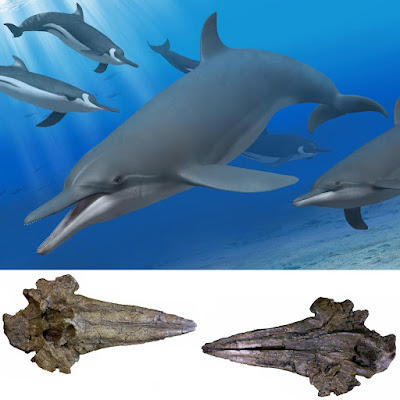|
|
| Пишет Species New to Science ( @ 2020-07-09 12:12:00 |
|
|
|
|
|
|
|
|
|
|
|
|
|
|
[PaleoMammalogy • 2020] Norisdelphis annakaensis • A New Miocene Delphinid from Japan
 |
| Norisdelphis annakaensis Kimura & Hasegawa, 2020 llustration: Tatsuya Shinmura |
ABSTRACT
Two well-preserved delphinid crania have been recovered from the Haraichi Formation, Annaka Group, Gunma Prefecture, Japan (earliest late Miocene, Tortonian; 11.29–11.25 Ma). The specimens represent a new genus and species of delphinid, Norisdelphis annakaensis. The new species is characterized by transversely narrow and anteroposteriorly elongated external bony nares, and a wider proximal extremity of the left premaxilla. Phylogenetic analysis suggests that Norisdelphis is the most basal member of the Delphinidae. The previous oldest known described delphinid, Eodelphinus kabatensis, is from the upper Miocene (ca. 9 Ma), and other reliably dated and described fossil delphinids are no older than Pliocene; thus, N. annakaensis is the oldest convincingly dated and well-diagnosed fossil delphinid species yet described. Norisdelphis annakaensis expands the geological range of the family Delphinidae.
 |
| Norisdelphis annakaensis, gen. et sp. nov., GMNH-PV-3463, holotype. Photographs of the cranium in dorsal (A) and ventral (B) views. |
SYSTEMATIC PALEONTOLOGY
Suborder ODONTOCETI Flower, 1867
Infraorder DELPHINIDA Muizon, 1984
Superfamily DELPHINOIDEA Gray, 1821
Family DELPHINIDAE Gray, 1821
NORISDELPHIS, gen. nov.
Norisdelphis annakaensis, sp. nov.
Etymology—From Greek, norís, meaning early, and delphis, dolphin.
NORISDELPHIS ANNAKAENSIS, sp. nov.
Etymology— Named for Annaka City, Gunma, Japan, where the holotype and the paratype were found.
 |
llustration: Tatsuya Shinmura |
Toshiyuki Kimura and Yoshikazu Hasegawa. 2020. Norisdelphis annakaensis, A New Miocene Delphinid from Japan. Journal of Vertebrate Paleontology. e1762628. DOI: 10.1080/02724634.2020.1762628
安中で発見のマイルカ科化石 1130万年前で世界最古&新種と認定

